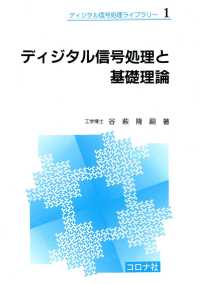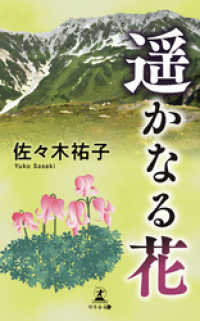Full Description
Much has been written in Canada and South Africa about sexual violence in the context of colonial legacies, particularly for Indigenous girls and young women. While both countries have attempted to deal with the past through Truth and Reconciliation Commissions and Canada has embarked upon its National Inquiry on Missing and Murdered Indigenous Women and Girls, there remains a great deal left to do. Across the two countries, history, legislation and the lived experiences of young people, and especially girls and young women point to a deeply rooted situation of marginalization. Violence on girls' and women's bodies also reflects violence on the land and especially issues of dispossession. What approaches and methods would make it possible for girls and young women, as knowers and actors, especially those who are the most marginalized, to influence social policy and social change in the context of sexual violence?
Taken as a whole, the chapters in Disrupting Shameful Legacies: Girls and Young Women Speaking Back through the Arts to Address Sexual Violence which come out of a transnational study on sexual violence suggest a new legacy, one that is based on methodologies that seek to disrupt colonial legacies, by privileging speaking up and speaking back through the arts and visual practice to challenge the situation of sexual violence. At the same time, the fact that so many of the authors of the various chapters are themselves Indigenous young people from either Canada or South Africa also suggests a new legacy of leadership for change.
Contents
Acknowledgements
List of Figures and Tables
The Life You Stole
Hannah Batiste
1. Disrupting Shameful Legacies: Girls and Young Women Speak Back through the Arts to Address Sexual Violence
Claudia Mitchell and Relebohile Moletsane
Part 1: What's Engagement Got to Do with It?
2. Sisters Rising: Shape Shifting Settler Violence through Art and Land Retellings
Sandrina De Finney, Shantelle Moreno, Anna Chadwick, Chantal Adams, Shezell-Rae Sam, Angela Scott and Nicole Land
3. "Just Don't Change Anything": Engaging Girls in Participatory Visual Research to Address Sexual Violence in Rural South Africa
Astrid Treffry-Goatley, Relebohile Moletsane and Lisa Wiebesiek
4. "We Are Strong. We Are Beautiful. We Are Smart. We Are Iskwew": Saskatoon Indigenous Girls Use Cellphilms to Speak Back to Gender-Based Violence
Jennifer Altenberg, Sarah Flicker, Katie MacEntee and Kari-Dawn Wuttunee
5. Pictures Speak for Themselves: Youth Engaging through Photovoice to Describe Sexual Violence in Their Community
Ndumiso Daluxolo Ngidi, Sinakekelwe Khumalo, Zaynab Essack and Candice Groenewald
6. Using Drawings to Explore Sexual Violence with Orphaned Youth in and around a Township Secondary School in South Africa
Ndumiso Daluxolo Ngidi and Relebohile Moletsane
7. Using Participatory Visual Methodologies to Engage Secondary School Learners in Addressing Sexual and Reproductive Health Issues
Brian B. Sibeko and Samkelisiwe F. Luthuli
Part 2: Engaging Images
8. Seeing Things: Schoolgirls in a Rural Setting Using Visual Artefacts to Initiate Dialogue about Resisting Sexual Violence
Marianne Adam and Naydene de Lange
9. (Ad)Dressing Sexual Violence: Girls and Young Women Creatively Resisting through Dress
María Ezcurra and Claudia Mitchell
10. Affective Possibilities for Addressing Sexual Violence through Art: Reflections across Two Sites
Pamela Lamb
11. In Contrast: Media Coverage and Annie Pootoogook's Drawings of Sexual Violence and Sexual Happiness
Haidee Smith Lefebvre
12. Curating Children's Drawings: Exploring Methods and Tensions in Children's Depictions of Sexual Violence
Fatima Khan
Part 3: Reflections and Re-Imaginings
13. A Collective Triologue on Sexualised Violence and Indigenous Women
Marnina Gonick, Veronica Gore and Lisa Christmas
14. Girls and Young Women Creatively Addressing Sexual Violence Online: Exploring the Successes, Challenges, and Possibilities
Laurel Hart
15. How We See It: What Can Girls and Young Women Learn from National and Transnational Dialogue about Sexual Violence
Bongiwe Maome
16. Methodological Reflections on a Visual Participatory Study on Resilience Processes of African Girls with a History of Child Sexual Abuse
Sadiyya Haffejee, Twinky Banda and Linda Theron
17. Unsettling: Musings on Ten Years of Collaborations with Indigenous Youth as a White Settler Scholar
Sarah Flicker
List of Contributors
Index








